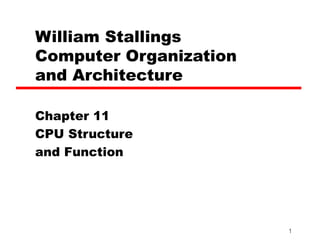
Chapter 7 cpu struktur dan fungsi
- 1. William Stallings Computer Organization and Architecture Chapter 11 CPU Structure and Function 1
- 2. CPU Structure CPU must: Fetch instructions Interpret instructions Fetch data Process data Write data 2
- 3. Registers CPU must have some working space (temporary storage) Called registers Number and function vary between processor designs One of the major design decisions Top level of memory hierarchy 3
- 4. User Visible Registers General Purpose Data Address Condition Codes 4
- 5. General Purpose Registers (1) May be true general purpose May be restricted May be used for data or addressing Data Accumulator Addressing Segment 5
- 6. General Purpose Registers (2) Make them general purpose Increase flexibility and programmer options Increase instruction size & complexity Make them specialized Smaller (faster) instructions Less flexibility 6
- 7. How Many GP Registers? Between 8 - 32 Fewer = more memory references More does not reduce memory references and takes up processor real estate See also RISC 7
- 8. How big? Large enough to hold full address Large enough to hold full word Often possible to combine two data registers C programming double int a; long int a; 8
- 9. Condition Code Registers Sets of individual bits e.g. result of last operation was zero Can be read (implicitly) by programs e.g. Jump if zero Can not (usually) be set by programs 9
- 10. Control & Status Registers Program Counter Instruction Decoding Register Memory Address Register Memory Buffer Register Revision: what do these all do? 10
- 11. Program Status Word A set of bits Includes Condition Codes Sign of last result Zero Carry Equal Overflow Interrupt enable/disable Supervisor 11
- 12. Supervisor Mode Intel ring zero Kernel mode Allows privileged instructions to execute Used by operating system Not available to user programs 12
- 13. Other Registers May have registers pointing to: Process control blocks (see O/S) Interrupt Vectors (see O/S) N.B. CPU design and operating system design are closely linked 13
- 15. Foreground Reading Stallings Chapter 11 Manufacturer web sites & specs 15
- 16. Instruction Cycle Revision Stallings Chapter 3 16
- 17. Indirect Cycle May require memory access to fetch operands Indirect addressing requires more memory accesses Can be thought of as additional instruction subcycle 17
- 18. Instruction Cycle with Indirect 18
- 19. Instruction Cycle State Diagram 19
- 20. Data Flow (Instruction Fetch) Depends on CPU design In general: Fetch PC contains address of next instruction Address moved to MAR Address placed on address bus Control unit requests memory read Result placed on data bus, copied to MBR, then to IR Meanwhile PC incremented by 1 20
- 21. Data Flow (Data Fetch) IR is examined If indirect addressing, indirect cycle is performed Right most N bits of MBR transferred to MAR Control unit requests memory read Result (address of operand) moved to MBR 21
- 22. Data Flow (Fetch Diagram) 22
- 23. Data Flow (Indirect Diagram) 23
- 24. Data Flow (Execute) May take many forms Depends on instruction being executed May include Memory read/write Input/Output Register transfers ALU operations 24
- 25. Data Flow (Interrupt) Simple Predictable Current PC saved to allow resumption after interrupt Contents of PC copied to MBR Special memory location (e.g. stack pointer) loaded to MAR MBR written to memory PC loaded with address of interrupt handling routine Next instruction (first of interrupt handler) can be fetched 25
- 26. Data Flow (Interrupt Diagram) 26
- 27. Prefetch Fetch accessing main memory Execution usually does not access main memory Can fetch next instruction during execution of current instruction Called instruction prefetch 27
- 28. Improved Performance But not doubled: Fetch usually shorter than execution Prefetch more than one instruction? Any jump or branch means that prefetched instructions are not the required instructions Add more stages to improve performance 28
- 29. Pipelining Fetch instruction Decode instruction Calculate operands (i.e. EAs) Fetch operands Execute instructions Write result Overlap these operations 29
- 30. Timing of Pipeline 30
- 31. Branch in a Pipeline 31
- 32. Dealing with Branches Multiple Streams Prefetch Branch Target Loop buffer Branch prediction Delayed branching 32
- 33. Multiple Streams Have two pipelines Prefetch each branch into a separate pipeline Use appropriate pipeline Leads to bus & register contention Multiple branches lead to further pipelines being needed 33
- 34. Prefetch Branch Target Target of branch is prefetched in addition to instructions following branch Keep target until branch is executed Used by IBM 360/91 34
- 35. Loop Buffer Very fast memory Maintained by fetch stage of pipeline Check buffer before fetching from memory Very good for small loops or jumps c.f. cache Used by CRAY-1 35
- 36. Branch Prediction (1) Predict never taken Assume that jump will not happen Always fetch next instruction 68020 & VAX 11/780 VAX will not prefetch after branch if a page fault would result (O/S v CPU design) Predict always taken Assume that jump will happen Always fetch target instruction 36
- 37. Branch Prediction (2) Predict by Opcode Some instructions are more likely to result in a jump than thers Can get up to 75% success Taken/Not taken switch Based on previous history Good for loops 37
- 38. Branch Prediction (3) Delayed Branch Do not take jump until you have to Rearrange instructions 38
- 40. Foreground Reading Processor examples Stallings Chapter 11 Web pages etc. 40
Notas do Editor
- 22
- 23
- 24
- 25
- 26
- 27
- 28
- 29
- 30
- 31
- 32
- 33
- 34
- 35
- 36
- 37
- 38
- 39
- 40
- 41
- 42
- 43
- 44
- 45
- 46
- 47
- 48